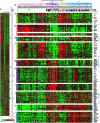Gene expression profiling identifies clinically relevant subtypes of prostate cancer
- PMID: 14711987
- PMCID: PMC321763
- DOI: 10.1073/pnas.0304146101
Gene expression profiling identifies clinically relevant subtypes of prostate cancer
Abstract
Prostate cancer, a leading cause of cancer death, displays a broad range of clinical behavior from relatively indolent to aggressive metastatic disease. To explore potential molecular variation underlying this clinical heterogeneity, we profiled gene expression in 62 primary prostate tumors, as well as 41 normal prostate specimens and nine lymph node metastases, using cDNA microarrays containing approximately 26,000 genes. Unsupervised hierarchical clustering readily distinguished tumors from normal samples, and further identified three subclasses of prostate tumors based on distinct patterns of gene expression. High-grade and advanced stage tumors, as well as tumors associated with recurrence, were disproportionately represented among two of the three subtypes, one of which also included most lymph node metastases. To further characterize the clinical relevance of tumor subtypes, we evaluated as surrogate markers two genes differentially expressed among tumor subgroups by using immunohistochemistry on tissue microarrays representing an independent set of 225 prostate tumors. Positive staining for MUC1, a gene highly expressed in the subgroups with "aggressive" clinicopathological features, was associated with an elevated risk of recurrence (P = 0.003), whereas strong staining for AZGP1, a gene highly expressed in the other subgroup, was associated with a decreased risk of recurrence (P = 0.0008). In multivariate analysis, MUC1 and AZGP1 staining were strong predictors of tumor recurrence independent of tumor grade, stage, and preoperative prostate-specific antigen levels. Our results suggest that prostate tumors can be usefully classified according to their gene expression patterns, and these tumor subtypes may provide a basis for improved prognostication and treatment stratification.
Figures



References
-
- Parkin, D. M., Bray, F. I. & Devesa, S. S. (2001) Eur. J. Cancer 37, S4–S66. - PubMed
-
- Hsing, A. W., Tsao, L. & Devesa, S. S. (2000) Int. J. Cancer 85, 60–67. - PubMed
-
- Jemal, A., Murray, T., Samuels, A., Ghafoor, A., Ward, E. & Thun, M. J. (2003) CA Cancer J. Clin. 53, 5–26. - PubMed
-
- Farkas, A., Schneider, D., Perrotti, M., Cummings, K. B. & Ward, W. S. (1998) Urology 52, 444–448; discussion, 448–449. - PubMed
-
- Han, M., Partin, A. W., Piantadosi, S., Epstein, J. I. & Walsh, P. C. (2001) J. Urolol. 166, 416–419. - PubMed
Publication types
MeSH terms
Substances
Grants and funding
LinkOut - more resources
Full Text Sources
Other Literature Sources
Medical
Molecular Biology Databases
Research Materials
Miscellaneous

